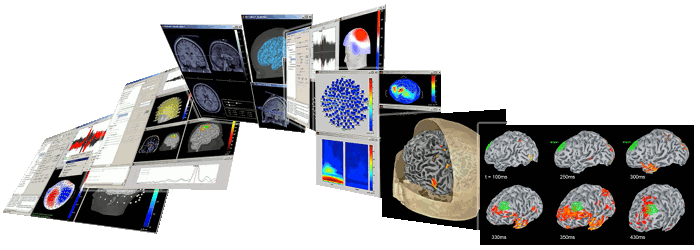|
Size: 12337
Comment:
|
Size: 12331
Comment:
|
| Deletions are marked like this. | Additions are marked like this. |
| Line 10: | Line 10: |
| * '''New training opportunities''': Montreal (Nov 7-11) - [[Training|Register now]] | * '''New training opportunities''': Montreal (Nov 7-11), San Diego (Nov 10) - [[Training|Register]] |
| Line 12: | Line 12: |
| * '''Latest software updates''': [[News]] * '''Stay in touch''': Follow us on [[http://www.facebook.com/BrainstormSoftware|Facebook]] |
* '''Latest software updates''': [[News]] | Follow us on [[http://www.facebook.com/BrainstormSoftware|Facebook]] |

News
New training opportunities: Montreal (Nov 7-11), San Diego (Nov 10) - Register
New position opening: Research assistant in Montreal - Apply now
Introduction
Brainstorm is a collaborative, open-source application dedicated to MEG/EEG/sEEG/ECoG data analysis: visualization, processing and advanced source modeling.
Our objective is to share a comprehensive set of user-friendly tools with the scientific community using MEG/EEG as an experimental technique. For physicians and researchers, the main advantage of Brainstorm is its rich and intuitive graphic interface, which does not require any programming knowledge. We are also putting the emphasis on practical aspects of data analysis (e.g., with scripting for batch analysis and intuitive design of analysis pipelines) to promote reproducibility and productivity in MEG/EEG research. Finally, although Brainstorm is developed with Matlab (and Java), it does not require users to own a Matlab license: an executable, platform-independent (Windows, MacOS, Linux) version is made available in the downloadable package. To get an overview of the interface, you can watch this introduction video.
Since the project started by the end of the 1990's, our server has registered more than 13,000 accounts. See our reference page for a list of published studies featuring Brainstorm at work.
The best way to learn how to use Brainstorm, like any other academic software, is to benefit from local experts. However, you may be the first one in your institution to consider using Brainstorm for your research. We are happy to provide comprehensive online tutorials and support through our forum but there is nothing better than a course to make your learning curve steeper. Consult our training pages for upcoming opportunities to learn better and faster.
Finally, have a look regularly at our What's new page for staying on top of Brainstorm news and updates and  Like us on Facebook to stay in touch. We hope you enjoy using Brainstorm as much as we enjoy developing and sharing these tools with the community!
Like us on Facebook to stay in touch. We hope you enjoy using Brainstorm as much as we enjoy developing and sharing these tools with the community!
Support
This software was generated primarily with support from the National Institutes of Health under grants 2R01-EB009048, R01-EB009048, R01-EB002010 and R01-EB000473.
Primary support was provided by the Centre National de la Recherche Scientifique (CNRS, France) for the Cognitive Neuroscience & Brain Imaging Laboratory (La Salpetriere Hospital and Pierre & Marie Curie University, Paris, France), and by the Montreal Neurological Institute to the MEG Program at McGill University.
Additional support was also from two grants from the French National Research Agency (ANR) to the Cognitive Neuroscience Unit (PI: Ghislaine Dehaene; Inserm/CEA, Neurospin, France) and to the ViMAGINE project (PI: Sylvain Baillet; ANR-08-BLAN-0250), and by the Epilepsy Center in the Cleveland Clinic Neurological Institute.
How to cite Brainstorm
Please cite the following reference in your publications if you have used our software for your data analyses: How to cite Brainstorm. It is also good offline reading to get an overview of the main features of the application.
Tadel F, Baillet S, Mosher JC, Pantazis D, Leahy RM (2011)
Brainstorm: A User-Friendly Application for MEG/EEG Analysis
Computational Intelligence and Neuroscience, vol. 2011, ID 879716
What you can do with Brainstorm
MEG/EEG ecordings:
Digitize the position of the EEG electrodes and the subject's head shape (link)
- Support for multiple modalities: MEG, EEG, sEEG, ECoG, animal LFP
Read data from the most popular file formats (link)
Interactive access to data files in native formats (?link)
- Import data in Matlab
- Import and order data in a well-organized database (by studies, subjects, conditions)
- Review, edit, import, export event markers in continuous, ongoing recordings
Automatic detection of well-defined artifacts: eye blinks, heartbeats... (?link)
Artifact correction: Signal Space Projections (?SSP) and Independent Component Analysis (ICA)
Pre-processing: (?link)
Powerful and versatile visualization:
Various time series displays (?link)
- Data mapping on 2D or 3D surfaces (disks, true geometry of sensor array, scalp surface, etc.)
- Generate slides and animations (export as contact sheets, snapshots, movies, ...)
- Flexible montage editor, channel selection and sensor clustering
MRI visualization and coregistration:
- Generate surfaces from MRI volume: head, inner skull and outer skull
- Use individual or template anatomy (MNI / Colin27 or ICBM152 brain)
Template anatomy can be warped to individual head surface (link)
Import MRI volumes and tessellated surface envelopes (link)
- Automatic or interactive co-registration with the MEG/EEG coordinate system
- Volume rendering (multiple display modes)
Anatomical atlases: surface parcelations and sub-cortical regions (link)
Database: Keep your data organized
- Ordering of data by protocol, subject and condition/event
- Quick access to all the data in a study for efficient, batch processing
- Quick access to comparisons between subjects or conditions
Graphical batching tools:
Head modeling: (?link)
- MEG: Single sphere, overlapping spheres
- EEG: Berg's three-layer sphere, Boundary Element Models (with OpenMEEG)
- sEEG/ECoG: Boundary Element Models (with OpenMEEG)
- Interactive interface to define the best-fitting sphere
Source modeling: (?link)
- L2 Minimum-norm current estimates
- dSPM
- sLORETA
- All models can be cortically-constrained or not, and with/without constrained orientations
Dipole scanning (link)
Dipole fitting with FieldTrip
- Simulation of MEG/EEG recordings from source activity
Source display and analysis:
- Multiple options for surface and volume rendering of the source maps
- Re-projection of the sources in the MRI volume (from surface points to voxels)
Definition of regions of interest (?scouts)
- Projection of estimated sources on a surface with higher or lower resolution
- Projection on a group template
- Surface or volume spatial smoothing (for group analysis)
- Share your results: screen captures, make movies and contact sheets!
Import and display of Neuromag's Xfit and CTF's DipoleFit dipole models (link)
Time-frequency decompositions:
Time-frequency analyses of sensor data and sources time series using Morlet wavelet, Fast Fourier Transform and Hilbert transform (?link)
- Define time and frequency scales of interest
- Multiple display modes available
Functional connectivity:
- Correlation, coherence, Granger causality, phase-locking value
- Phase-amplitude coupling estimation
- Both at sensor and source levels
- Dynamic circle plots for representing dense and high-dimensional connectivity graphs
Group analysis:
- Registration of individual brains to a brain template
- Parametric statistics (t-tests)
Non-parametric statistics (FieldTrip cluster-based analysis)
Documentation and support:
- Easy and automatic updates of the software
Detailed step-by-step tutorials for most common features
Active user forum supported by a large user community
Supported file formats
EEG / Electrophysiology:
- ANT EEProbe continuous (.cnt)
- BDF / BDF+ (Biosemi 24bit binary)
- BESA exports (.avr, .mul)
Blackrock NeuroPort (.nev, .nsX)
BrainVision BrainAmp (.eeg)
BrainVision Analyzer (.txt)
- Cartool binary files (.ep, .eph)
Compumedics ProFusion Sleep (.rda)
- Deltamed Coherence-Neurofile export (.txt/.bin)
- EDF / EDF+ (European Data Format)
- EEGLab sets (.set)
EGI NetStation epoch-marked file (.raw/.epoc)
FieldTrip structures (.mat)
- g.tec / g.Recorder Matlab exports (.mat)
- MANSCAN Microamp (.mbi/.mb2)
MEGA NeurOne (.bin)
- Neuralynx (.ncs)
- Neuroscan (.cnt, .eeg, .avg, .dat)
NeuroScope (*.eeg;*.dat)
- Any type of ASCII (text) files
MEG:
- CTF (.ds folders)
- Elekta Neuromag FIFF (.fif)
- BTi / 4D Neuroimaging
- KRISS MEG (.kdf)
- BabyMEG system (.fif)
- Yokogawa / KIT
Other recordings:
EyeLink eye tracker (.edf)
Sensors locations:
- ANT Xensor (.elc)
- BESA (.sfp, .elp, .eps/.ela)
BrainVision CapTrak (.bvct)
BrainVision electrode file (.bvef)
- Cartool (.xyz, .els)
- Curry (.res, .rs3)
- EEGLab (.ced, .xyz, .set)
- EETrak (.elc)
- EGI (.sfp)
- EMSE (.elp)
- Neuroscan (.dat, .tri, .asc)
- Polhemus (.pos .pol .elp .txt)
- ASCII arrays
MRI volumes:
- Analyze (.img/.hdr)
- BrainVISA GIS (.ima/.dim)
- CTF (.mri)
- MINC (.mnc)
- MGH (.mgh, .mgz)
- Neuromag (.fif)
- Nifti-1 (.nii, .nii.gz)
Surface meshes:
- BrainVISA (.mesh)
BrainSuite (.dsgl, .dfs)
- Curry BEM surfaces (.db*, .s0*)
FreeSurfer (lh.*, rh.*)
- FSL: VTK (.vtk)
- FSL: Geomview (.off)
- MNI obj (.obj)
- ASCII (.tri)
- Neuromag (.fif)
- 3D masks or atlases from MRI files (tesselation is automatically created)
Surface atlases:
BrainSuite (.dfs)
FreeSurfer (.annot, .label)
- Gifti texture (.gii)
- SUMA atlas (.dset)
Dipole models:
- Elekta Neuromag XFit (.bdip)


